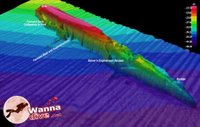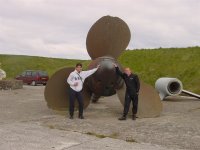Last Scapa Flow post:
I woke up this morning feeling 100% restored of yesterday’s dive. I don’t know if the problem was the deep dive or just that I was a little sea sick. I went to bed yesterday around 7:00pm and got up today at 8am.
Well… one more day of diving ahead and that’s what matters.

Today’s targets are the Dresden and the Tabaka. We decided to repeat the Tabaka as it was the most enjoyable dive so far. I’m really looking forward doing it again.
The seabed under the Dresden is about 33m. It is lying down on its port side and the amidships is completely destroyed because of the savaging. The bow is still partially intact as the stern. The ship was launched on April 1917 and was of the same Dresden II class as the Coln. She displaced around 5500 tons and was able to reach up to 28 knots.

Her armament consisted of three 3.4 inch AA guns and 4 deck mounted torpedo tubes, apart from her mine layering capabilities. The Dresden carried about 200 mines and had a crew of approximately 600 men.
The ship was one of the scuttled ships, and the interesting part of it is that the Closing, took the Dresden in tow when it was with water almost above its deck in an attempt to bring the ship to shallower waters. The Closing was able to tow her half a mile far away from the Island of Cava, where she sank under 33m of water in 21 June 1919.
The plan was going down and up using the shot line and the Invincible would be around us on the surface to pick us up. We were all using EAN32.
The descent was without problems and as soon as I reach the ship’s starboard I was happy because I expected it to be around 18m and it was at 15. As a matter of fact the seabed was at 31m. Maybe this was because of the tide, but I just felt happy to have a safer shallower dive.
We went to the wrong direction when we came down and I realised that first than my buddies as I could only see the hull to my right arm. I tried to signal them, but they were finning fast, probably trying to get to a specific part of the boat, and disappeared of sight.
As I was using doubles and had loads of gas and no deco time, I decided to go over the top of the boat and meet them in the other side. Slower movement also meant less CO2, which usually hits me in the form of strong headaches when I do much effort under the water. So there I went to the other side, going over the bridge and the metal scrap, trying to identify some parts of the ship. I could see loads of anemone and starfish. Some really big crabs popped out of the holes made by the scrap, making my stomach to give me a hunger signal. :)
5 min later I met the guys by the officer’s quarters and I signalled the OK. I got the response back and off we went to the shot line.

As we approached the ship’s bow I lost the guys again, since the visibility was very poor (4m max). I decided to pop up the SMB since a search would be a waste of time as there was no current and I knew I was somewhere near the line.
When I got to the surface the guys were 20m away and some quick strokes got me closer to them and up to the Invincible.
The water temperature was freezing 9oC and we spent 43 min under. Starting gas 210bar, end gas 130bar. This time I took Tom’s wife mosquito with me as long as the M1. My computer worked like a charm (I set it up as bottom timer). There is nothing like some competition, huh? :D
After the dive we went to the Island of Hoy for our surface interval, as the Tabaka has to be dived on a specific tide (slack water).
The Island of Hoy is the second largest of the Orkney Islands. It is still not very big, being only about 10 miles by 5 miles. It has some hills, and its tallest point is about 480 feet, being the highest of the islands. Hoy also hosts a very interesting war museum. It is the Scapa Flow Visitor Centre & Naval Museum, which is near the area of the sinking of the Royal Oak.
The Museum is housed in the former oil pumping station of the Lyness Naval Base. The Royal Navy left in 1956 and the Centre was opened to the public in 1990. The museum has many attractions, including a small showcase of Second World War

equipment and a video show of the fleet scuttling, which happens inside an old oil tank that was cleaned and turned in part of the museum.
In addition to all this, you can also see an original steam pump, air raid shelter, some costal batteries, a 28ton propeller (from the HMS Hampshire – the ship that struck a mine north of the Orkneys, leading to the death of Lord Kitchener) and other original WWII equipment. A MUST!

I have also spent some time paying my respects to the brave men that fought the Second World War, but perished while performing their duties. There is a Royal Navy cemetery that holds the remains of these brave soldiers, including some German sailors that died in conflicts when the scuttling of the German fleet was happening. They were the last causalities of the Second World War. If you visit the wrecks and have a good idea what the conflict was, maybe you also want to pay a visit to these brave men that gave their lives for their countries.
Well… the tide was right and we had to go. After finishing the museum and the cemetery visit we departed to the Tabaka.
I was very disappointed to know that 3 other ships were lining up with divers for the site as well. I don’t like crowded penetration dives, so we all decided to abort it. I was sad since the Tabaka was a dive I was really looking forward to do. We decided to do the Gobernador Bories instead.
I was puzzled by this name. In Spanish the word “governor” is “governador”. I also know that the “v” in Spanish sounds like like “b”. So, in my understanding the name of the ship should be “Governador Bories” instead of “Gobernador Bories”. In Rod Macdonald’s book it is written like “Gobernador”, but I’m still not convinced that this is a spelling mistake.
Never mind about that since the ship is under just 16 meters of waters and waiting to be dived.
The ship is a 2300 ton steamer built in 1882 and sunk in 1915. She stays in the same channel as the Inverlane, and is affected by strong current. That makes the diving a little more difficult, but gives the advantage of making the water clearer, since it brings water from outside the flow. It is a typical Burra Sound’s dive with good visibility (up to 30m!).
One of the good things is that you can use the hull to be protected from the current, and enjoy a good calm dive as you explore the remains of the wreck. The ascent, though, should not be by using a line. Unless you want to be hanging in a join line like a flag in a pole, it is better to use your SMB and ascend slowly as a good captain will follow the divers with the current picking them up as soon as they surface.

The ship sits on her keel, and you can have a fine panorama with a slight list to starboard. Her bow and starboard side of her hull are mostly intact, and there are some good overhead parts that an experienced diver would enjoy. There is light everywhere, which, with the good visibility, makes it a safe and enjoyable dive. The two boilers are exposed and are in the amidships.
Close to the stern, there is a small “sandy beach”, which is an area in the middle of the wreck with no rocks. The light makes a beautiful contrast as we ended our dive and popped our SMBs to the surface.
Again, the Invincible didn’t fail to pick us up on the surface on time… another nice dive for the logbook.
We came back to the flow in the end of the day, telling our stories and talking about another good day of diving.
The next day we dived the Koln and the F2 again. It was our last day. You can find more info about these two dives in:
F2:
http://www.divesitedirectory.co.uk/dive_site_uk_scotland_scapa_wreck_f2.htmlKoln:
http://www.submerged.co.uk/scapaflow_koln.phpWe all ended our trip wanting to come back. Scapa is an awesome place! A very good dive site for all experienced divers who love shipwrecks and want something more than just look at fish... :)

More info and all photos I took in this trip can be found at my pics website:
http://daniel.videopic.net (Scapa Gallery)









